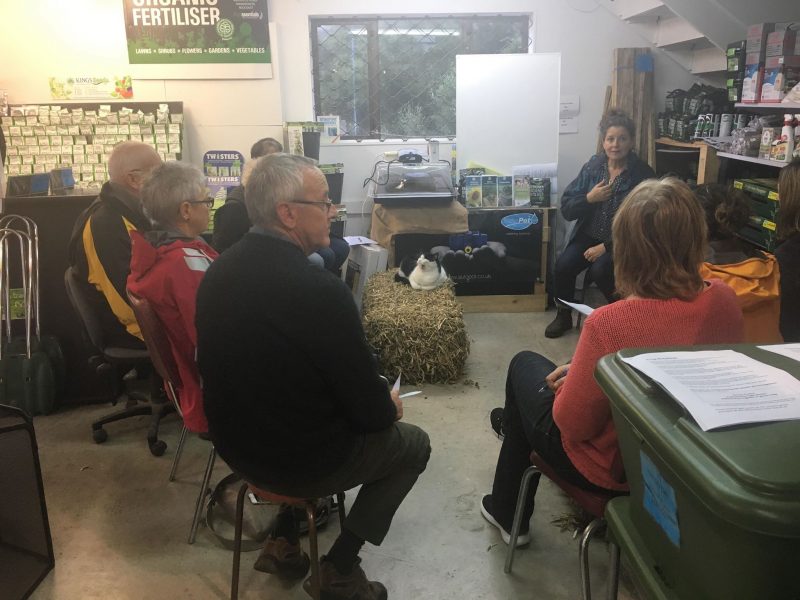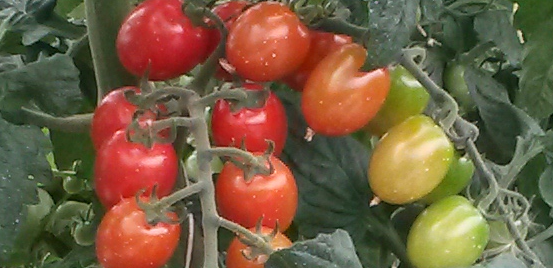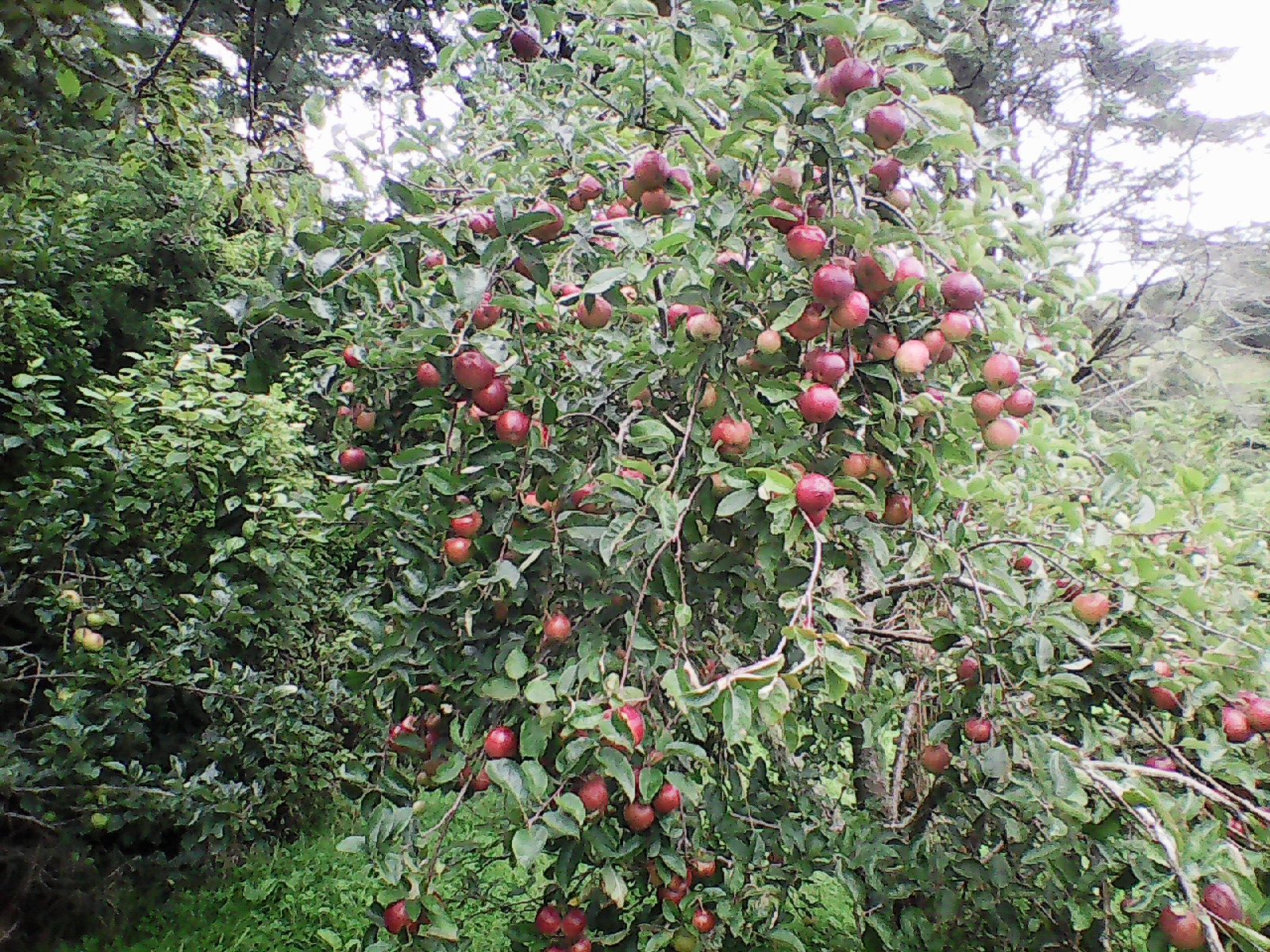
Winter is here
Workshop with Hannah Zwartz - Kapiti Green Gardener
In May we hosted Hannah Zwartz the Kapiti Green Gardener for a well-attended and very inspiring workshop on planning the garden for spring. The day was miserable, but we had the fire lit in the shop and poea straw bales to perch on to make it warm. Check out Ponics - the cat in the photo! He's caught doing a huge yawn. He's such a character wanting to be the center of attention. We started with everyone describing their garden and issues they were interested in. This lead to discussions on a number of issues that were interesting and varied. The main points covered were:- · Refresh your garden beds. · Green manure · Crop Rotational planting.
· Companion planting
There were also so many gems of knowledge that were mentioned in passing.
If you have dry patches in your garden put more compost in there to increase the humus and help the water retention.
The lemon and citrus peels can go back under the citrus trees to provide the correct balance for the citrus tree.
If you have out of control comfrey – cover it with plastic for a year to get rid of it, any shorter timeframe it will recover.
Shape chicken wire into a barrel shape and fill with the leaf litter to create compost.
If building new garden beds create a cold compost bin or pile where you want the garden. Put a layer of cardboard down first and build on top of that – remember to take the tape off first or you’ll end up with bits of tape through the garden. If you start this now by mid spring you will have a rich bed.
Horse manure is great for creating compost but make sure it’s well-rotted before you add it to the garden to ensure you’re not adding weeds to the garden. We always have bags of horse manure available at the shop for a gold coin donation to HUHA.
It was such a successful workshop that we will be organising another in September. Watch this space.
· Crop Rotational planting.
· Companion planting
There were also so many gems of knowledge that were mentioned in passing.
If you have dry patches in your garden put more compost in there to increase the humus and help the water retention.
The lemon and citrus peels can go back under the citrus trees to provide the correct balance for the citrus tree.
If you have out of control comfrey – cover it with plastic for a year to get rid of it, any shorter timeframe it will recover.
Shape chicken wire into a barrel shape and fill with the leaf litter to create compost.
If building new garden beds create a cold compost bin or pile where you want the garden. Put a layer of cardboard down first and build on top of that – remember to take the tape off first or you’ll end up with bits of tape through the garden. If you start this now by mid spring you will have a rich bed.
Horse manure is great for creating compost but make sure it’s well-rotted before you add it to the garden to ensure you’re not adding weeds to the garden. We always have bags of horse manure available at the shop for a gold coin donation to HUHA.
It was such a successful workshop that we will be organising another in September. Watch this space.
 Home and Living Show
Home and Living Show
The last weekend in May saw us with a stall at the Home and Living show at the Westpac Stadium. Again, it was very cold and miserable in Wellington. We had lots of interest in our Autopot range and the microgreens we had on display. Heather, Julie and I talked non-stop for three days to get the word out there.
At the show we offered a Home Watering Kit as a prize and this was won by Lee Geraghty. Lee came into the shop in the weekend to find out how to set it up correctly and saw all we have to offer. A huge thank you to everyone who entered. Please come in and let us show you what you can achieve in the garden.
Autopot News
 We pushed the season in February by planting a new round of what is really summer plants but we have been rewarded with a harvest of Beans, peppers and tomatoes in the green house. At home the peppers are still giving us produce even though I just filled up the tank and have basically forgotten about them. Gardening is always a learning curve no matter how long you have been doing it. After this I will definitely leave my greenhouse plants in longer and postpone the greenhouse tidy.
For winter we have cauliflower, broccoli, celery and cabbage in the Autopots in the greenhouse and they are coming along nicely. The broccoli hasn’t done as well as last year but that’s probably the interruption they got being dragged to the Home and living show.
The grow tent in the shop is doing well. I’ve shortened the “daylight” from the original 16 hours on and 8 hours off to 14 hours on and 10 hours off. This is supposed to simulate the shortening of daylight around autumn and encourages the plants to set fruit and get on with it. We have 2 types of pepper in there. A small variety “Jingle Bells” which are about the size of a golf ball and multi coloured. Apparently, they are great for stuffing with Feta and Olives. Then there is the “Dulce Espana” variety which is a Spanish heirloom pepper, a bit like the Bulls Horn, forming long narrow fruit. If only half of the small fruit ripen we will be well stocked for Capsicum peppers! Lastly in there is the Tomato which is the variety “Sub artic plenty.” This has fruit forming about the size of ping pong balls now. It’s all very exciting and a great way to extend my passion for growing.
We pushed the season in February by planting a new round of what is really summer plants but we have been rewarded with a harvest of Beans, peppers and tomatoes in the green house. At home the peppers are still giving us produce even though I just filled up the tank and have basically forgotten about them. Gardening is always a learning curve no matter how long you have been doing it. After this I will definitely leave my greenhouse plants in longer and postpone the greenhouse tidy.
For winter we have cauliflower, broccoli, celery and cabbage in the Autopots in the greenhouse and they are coming along nicely. The broccoli hasn’t done as well as last year but that’s probably the interruption they got being dragged to the Home and living show.
The grow tent in the shop is doing well. I’ve shortened the “daylight” from the original 16 hours on and 8 hours off to 14 hours on and 10 hours off. This is supposed to simulate the shortening of daylight around autumn and encourages the plants to set fruit and get on with it. We have 2 types of pepper in there. A small variety “Jingle Bells” which are about the size of a golf ball and multi coloured. Apparently, they are great for stuffing with Feta and Olives. Then there is the “Dulce Espana” variety which is a Spanish heirloom pepper, a bit like the Bulls Horn, forming long narrow fruit. If only half of the small fruit ripen we will be well stocked for Capsicum peppers! Lastly in there is the Tomato which is the variety “Sub artic plenty.” This has fruit forming about the size of ping pong balls now. It’s all very exciting and a great way to extend my passion for growing.
 Heather's Corner
Heather's Corner
Grr Garlic Rust
Seeing it’s time to plant garlic again we have been talking about last year’s dismal crop. Like everyone else we were affected by rust. We found this article on the internet so pasted some relevant points for you to see. A severe case of garlic rust, especially one that appears early in the season, can reduce bulb development or kill an entire crop outright. Homemade remedies (with mixed results) can be found online, but in all honesty, there’s not much an organic gardener can do once garlic rust sets in. The only way to get rid of the fungus is by snipping off the leaves as soon as you see the rust starting to appear. Throw the infected leaves in the trash (not the compost bin!), wash your hands and clothes, and disinfect your shears to prevent the fungus from spreading. Even with the infected leaves removed, the garlic stalk should continue to photosynthesize and send energy down to the bulb. You are pretty much at the mercy of the weather when it comes to allium rust, but there are a few things you can do to try to prevent it: The fungus flourishes when the weather is cool, sunlight is low, and humidity is high. If you live in this type of climate or had a very wet/grey season, avoid watering your garlic plants late in the day, and especially avoid watering the leaves if they will not have a chance to dry out before evening. Grow your garlic in the sunniest spot possible and allow enough space between plants for air to circulate among the foliage. Rotate your crops and do not grow garlic in the same area where rust appeared in the previous three years on any allium crop. Even if your crop is plagued by garlic rust this season, all is not lost — you can still use the cloves as seed garlic for next season. A study conducted by the University of California found that seed garlic taken from rust-infected plants did not cause rust in the resulting new crop. Simply choose the largest cloves from the cream o’ the crop of your properly cured and stored garlic heads and give it another go this year! We also had problems with black aphids last year on all our alliums and found the best way to treat them was with Diatomaceous Earth. It works really well. Good luck this year.June Special
Buy 2 Revital compost for $15.00 - usually $8.50 each
Vaild to 15 July 2018
Offer only good in store, does not apply to online purchases.


